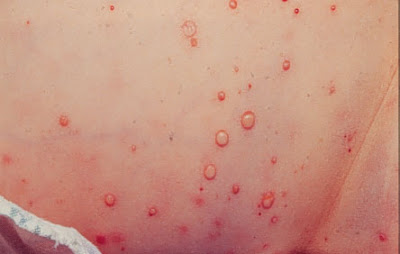
Dry flaky skin is caused by overheating during the winter and air conditioning during the summer — contributes to dryness and itching to the skin.
CAUSES
- Living in Low humidity.
- Home heating.
- Rubbing or drinking alcohol.
- Certain chemicals and cleaning products, which is not suited to skin.
HOMEMADE SOLUTIONS
- Use a deep-cleaning honey and almond moisturizing clay mask once a week after exfoliating. This helps maintain a clear complexion and honey and almond moisturizing facemask is particularly good for mature, sensitive, or dry skin.
- Rub half of an apple on skin to help even out the texture.
- Apply cream or good moisturizer before go to bed or sleeping.
DYSHIDROTIC DERMATITIS
Dyshidrotic dermatitis (pompholyx) is a form of hand eczema, slightly more common in women, which starts on the sides of the fingers as itchy little bumps and then develops into a rash. The condition can also affect only the feet. Some patients have involvement of both the hands and feet. It is often confused with a fungus.
CAUSES
People who have dyshidrotic dermatitis are genetically predisposed to it. Dyshidrotic dermatitis often appears during times of stress. Smokers have a higher incidence of Dyshidrotic Dermatitis condition. Ingestion of allergens such as chromate, neomycin, quinoline, or nickel may cause some cases.
SYMPTOMS
Some of the common symptoms of Dyshidrotic Dermatitis are: -
- The rash of dyshidrotic dermatitis occurs on the hands and feet. The majority of cases involve the palms and sides of the fingers, but the soles of the feet can also be involved.
- The rash looks like crops of clear, deep-seated, tapioca-like vesicles and is very itchy. The vesicles resolve in 3 to 4 weeks and are replaced by 1- to 3-mm rings of scale.
TREATMENT OF DYSHIDROTIC DERMATITIS
Some of common treatment of Dyshidrotic Dermatitis are :-
- Skin protection is an important part of treatment.
- Wear heavy-duty gloves when doing heavy work and gardening. Also wear cotton gloves when doing dry housework.
- Aluminum subacetate, or Burrow's Solution, is a drying soak that can be used if the lesions ooze.
- Antibiotics may be needed if the skin is broken and infection is suspected.
- Rings often worsen dermatitis by trapping irritating materials beneath them. Remove your rings when doing housework and before washing your hands.
- Oral methotrexate can be used in severe cases of Dyshidrotic Dermatitis.
- If you have a tendency to develop dyshidrotic dermatitis of the feet, you should wear socks, which are at least 60% cotton. You should change your shoes everyday. Alternate 2-3 pairs of shoes, so the shoes will dry out completely before you use them again.
- Aluminum chloride 20% (Drysol) may help in cases made worse by sweating.
- Avoid direct contact with turpentine, paint thinner and paints. Also polishes for furniture, metal, floors, and shoes. When using them, wear heavy-duty gloves because they contain irritating solvents.